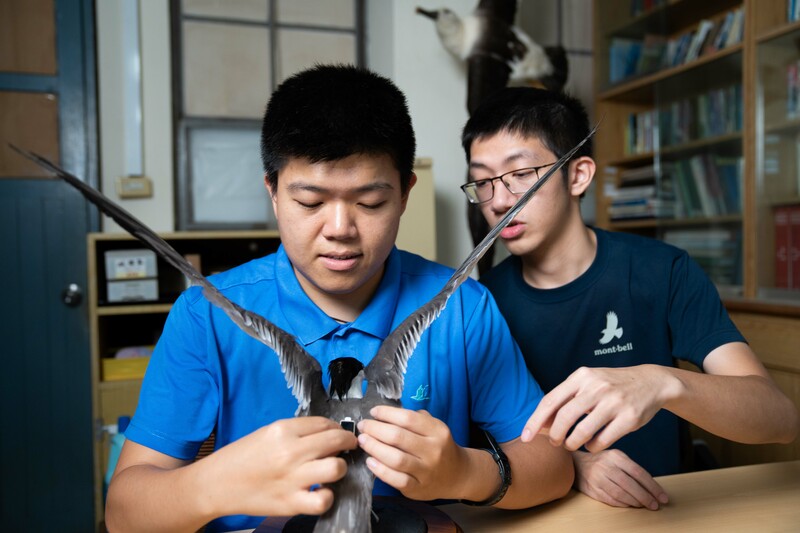Establishment of the Wildlife Research Laboratory
Around four or five decades ago, forests were primarily associated with timber utilization and forestry development. In a field dominated by timber resources at the time, few people considered including wildlife in the scope of forest research. However, Professor Hsiao-Wei Yuan firmly believed that forests are more than just collections of trees, as the relationship between wildlife and forests is inseparable. Forests are among the most biodiverse habitats on Earth, making their conservation, management, and biodiversity crucial topics for every forester to understand. To address these challenges, Professor Yuan established the Wildlife Research Laboratory, dedicating it to wildlife conservation and research while infusing forest ecosystems with academic vitality.
Wildlife Research Laboratory: Guardians of Taiwan’s Ecology
The Wildlife Research Laboratory covers a wide range of research fields, including avian behavioral ecology, population dynamics, habitat management, biodiversity monitoring, environmental impact assessment, and environmental education. The team boasts extensive experience in field investigations and analytical work. Over the past several decades, this laboratory has focused on studying unique and conservation-dependent species, conducting faunal assessments and monitoring, promoting biodiversity conservation and preservation, and developing principles and methods tailored to the management of local forest ecosystems. The team has undertaken numerous significant conservation research projects:
Restoration of Breeding Habitats and Reproductive Ecology of Blue-tailed Bee-eaters (Merops philippinus) on Kinmen Island
Blue-tailed Bee-eaters are primarily found in Southeast Asia, New Guinea, and southwestern China. On Kinmen Island, they are summer migratory birds, arriving annually from March to October to breed, with their peak breeding season occurring between May and August. These birds employ strategies such as colonial and cooperative breeding. As Kinmen transitioned into a tourism-driven region, development brought significant changes to the local landscapes and ecosystems. Natural habitats, such as earthen slopes, abandoned military trenches, and erosion gullies in Xiguoshan, became unstable, displacing the Bee-eaters, which exhibit strong site fidelity to their breeding grounds. To make Bee-eaters return and nest on Kinmen Island, Professor Hsiao-Wei Yuan and her research team launched the Kinmen Blue-tailed Bee-eater Conservation Project.
In 2003, the team constructed an artificial slope in Rushan; however, as the project was not completed in time for the breeding season of Bee-eaters, the outcome was less than ideal. Only a few bee-eaters flew by, and none stayed to use the newly created habitat. Subsequently, the team built additional nesting habitats at various locations, including Youth Farm and Tianpu Reservoir, while restoring the habitat near the triangular fortress at Cihu. With the assistance of Kinmen National Park, the team performed slope restoration for breeding purposes. This involved removing vegetation and old nest holes from the slopes, leveling the terrain, and compacting the soil to create stable and long-lasting nesting sites. Through monitoring, the team found that years of effort in constructing habitats led to a steady annual increase in the number of nesting Bee-eaters, eventually stabilizing their population. This restoration project benefited the birds and gave the public a chance to observe Blue-tailed Bee-eaters up close as the birds hunted for insects, bred, and raised their young. These experiences enhanced public awareness and understanding of the species’ ecology.


Restoration Efforts for Chinese Crested Terns (Thalasseus bernsteini)
Knowned as the "Mythic Bird," the Chinese Crested Tern is listed as Critically Endangered on the International Union for Conservation of Nature (IUCN) Red List. This species is regarded as a significant subject of study by both domestic and international ornithologists. The Wildlife Research Laboratory has long focused on tern-related issues and identified two key characteristics of Chinese Crested Terns: colonial breeding and migratory behavior. Research has shown that despite its wide distribution, the species’ population has plummeted due to the severe destruction of natural habitats. This has resulted in a biological "bottleneck effect," making it exceptionally difficult to restore the population to its original levels, particularly given that the Chinese Crested Terns have low reproductive capacity. To prevent the species from heading toward extinction, the Wildlife Research Laboratory collaborated with the Wild Bird Society of Taipei to secure conservation research funding from Taiwan’s Ministry of Science and Technology, Forestry Bureau of the Council of Agriculture, and Ocean Conservation Administration. These efforts focus on the restoration of terns in the Matsu Islands.
To better understand the migratory routes of Chinese Crested Terns, the team studied the Greater Crested Terns (T. bergii), which share migratory patterns and breeding grounds with Chinese Crested Terns. Satellite transmitters were attached to Greater Crested Terns to track and infer their migration routes. During the restoration process, the team actively enhanced the breeding environment, starting with weeding, predator removal, and installation of monitoring equipment on Tiejian Islet in the Matsu Islands. The team also employed the internationally recognized "decoy technique," placing artificial bird models made of resin at specific breeding sites and broadcasting bird calls. This approach leveraged the colonial tendencies of terns to attract them to the designated islands for protection and monitoring. Furthermore, going beyond conventional observation methods with binoculars, the team collaborated with Professor Joe-Air Jiang from the Department of Biomechatronics Engineering at National Taiwan University to develop an "automated bird behavior and habitat monitoring system." This innovative system leverages technology to transmit real-time breeding footage to the research laboratory, allowing the team to observe tern group behavior more promptly and comprehensively while also collecting valuable reproductive data.
Reflecting on the conservation journey, Professor Hsiao-Wei Yuan has led her team through decades of dedicated efforts, successfully increasing the population of the globally endangered Chinese Crested Tern. In addition, she has actively raised international awareness about the conservation of this species, highlighting Taiwan's commitment and achievements in preserving biodiversity on the global stage. As a result, in 2023, Professor Hsiao-Wei Yuan was awarded the Special Achievement Award by the Pacific Seabird Group.
Passing on the Passion: Students' Pursuit of Nature
With the rapid growth of popular industries like semiconductors and shifting workplace expectations among younger generations, fewer students are willing to endure the challenges of outdoor work, including exposure to wind, rain, and sun. However, within the Department of Forestry and the Wildlife Research Laboratory, Professor Hsiao-Wei Yuan is pleased to see a group of students who remain passionate about nature and committed to forest research. She enjoys guiding students in exploring their interests in plants and animals, encouraging them as researchers in forestry to venture into the wild despite technological advancements. She emphasizes the importance of engaging their senses—feeling the air, listening to birdsong, and building emotional connections with living organisms through interactions with nature. Through these experiences, students learn to respect the natural world. Professor Hsiao-Wei Yuan believes that fieldwork and laboratory analysis should complement and support each other seamlessly. By integrating these two approaches, students develop skills in field investigations and scientific research and gain a deeper appreciation for the importance of harmonious coexistence between humans and nature.
Mr. Han-Po Chang, who is a PhD student has been with the Wildlife Research Laboratory for over a decade, shared that the lab brings together experts from various fields, including ornithology, taxidermy, and forest therapy. Through interactions with these specialists, students broaden their professional horizons and gain hands-on experience with specialized equipment and facilities, including drones, remote sensing tools, and spotting scopes. Moreover, the lab serves not only as a cradle for students to accumulate practical fieldwork experience but also as a platform where they learn to collect and analyze data, integrate theory with practice, and develop independent research skills. For Mr. Chang, participating in numerous research projects has offered opportunities to travel extensively and interact with diverse communities. These experiences have enhanced his communication and interpersonal skills, allowing him to build connections and integrate seamlessly into various social groups. In mentoring junior colleagues during collaborative research, he has cultivated leadership and resource coordination skills while gaining a deeper appreciation for the importance of teamwork.


Crossing Boundaries: Interdisciplinary Collaboration and Innovation in Wildlife Research
The Wildlife Research Laboratory has collaborated with the University of Oregon in the United States and Zhejiang Museum of Natural History in China to conduct research on Chinese Crested Terns. Moreover, the laboratory has formed a research team with professors from the Department of Electrical Engineering, led by Taiwan's Ministry of Science and Technology to perform the Moonshot Project, which focuses on developing the Internet of Things (IoT) technology to apply artificial intelligence (AI) to real-time transmission of long-distance 8K virtual reality images. This project integrates drones with real-time 8K virtual reality image transmission systems for wildlife monitoring and evaluates the system’s effectiveness in wildlife recognition and sensing range. Once the long-distance image transmission module is fully developed, it will be mounted on drones and deployed in forests, oceans, and wetlands to conduct resource surveys in these protected areas, testing the feasibility of this innovative approach.
Plants and animals have inhabited Earth long before humans. However, in the pursuit of development, the human race has excessively exploited natural resources, leading to the destruction of countless species’ habitats. Since ancient times, humans have relied on natural resources for survival. However, the rate of resource consumption has far exceeded the Earth’s capacity, imposing a significant burden on the environment and posing a grave threat to biodiversity. Therefore, Professor Hsiao-Wei Yuan encourages the public to take proactive steps toward ecological conservation and to live in harmony with the natural environment. This is not merely a gesture of respect toward other species but also a fundamental necessity for humanity’s sustainable development, ensuring that Earth’s beauty endures for generations to come.
Learn more about LabSpotlight :https://labspotlight.ntu.edu.tw/



